40s Fashion Guys and Dolls Costumes
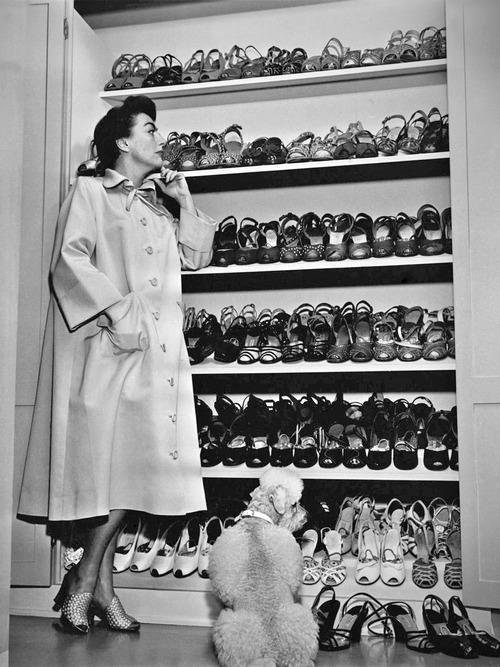
A Plethora of Shoes
Fashion in the 1950s brought the world out of the conservative war years and into the dazzling '50s. Dresses were bigger, accessories richer, hairstyles taller, and shoes.…well, plainer. With so much new accent on the rest of women'south fashion, 1950s shoe styles became understated accessories. Instead of bold patterns and piles of fancy adornments, shoes were bones swish unmarried color pumps, flats, wedgies, and loafers.
Blackness and chocolate-brown were the principal choices for solar day wear, while brighter colors were adequate for summertime sportswear or house slippers. Shoes also coordinated perfectly with an outfit'due south accessories past matching purses, gloves, belts, and fifty-fifty jewelry perfectly.
The 1950s shoe styles were varied, only nigh all came down to plumbing equipment into one of these pop silhouettes.
Shop 1950s manner shoes here.
1950s Pumps
In the early 1950s, the stiletto heeled opera, court, and pump shoes were all the rage. At an extreme, they were very tall with 4-inch spiked ultra thin heels. Early on, the heels ended in a small metal cap that left dents in soft wood floors, requiring some museum and court houses to forbid stiletto shoes. The stiletto featured alpine arches with a 5 shaped cutaway from the shoe sides. Red was the nigh bold and in-demand color for formalwear. They were impractical and by and large only worn for very special occasions, short durations, and by way models.
The winklepicker was a extreme version of the already extreme opera pump. With its abrupt pointy toe and high thin heel, it was trendy in the belatedly 1950s for formal and even semi-formal at-home article of clothing.
Thicker but still shapely tall heels connected to be worn with fancy dresses. Some heels had pretty all- over designs carved, painted or printed onto them, while others had decorations around the edges.
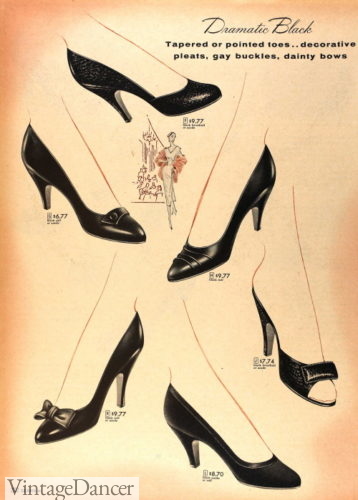
1957 evening heels
The very strappy alpine heel shoes were another ideal shoe for evening article of clothing. Ultra thin T-straps, slingbacks, and ankle straps all provided just enough coverage to go on the shoe on just ultimately made the human foot look bare. Peculiarly in nude colors and sometimes clear plastics, they complimented dreamy party dresses elegantly.
Lucile Ball wore tall chunky ankle strap shoes through most of the early 1950s. These were a carry over style from the 1940s worn by many pinup girls. While many shoes retained the thicker heels of the state of war years, specially for working classes, most fashion followers preferred the smaller narrow heeled shoes equally a rebellion from the masculine '40s.
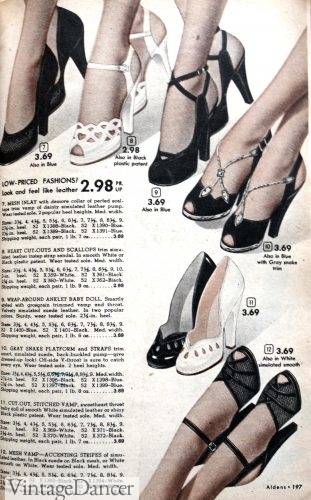
1952 Ankle strap heels
Later trying to residuum on tall heels, almost 1950s women regained their senses and accustomed low merely notwithstanding sparse kitten heel shoes. These classic dress shoes were safer to walk in, even so nevertheless remained elegant and swish. Shoes were fabricated of a soft leather or reptile skin. Suede and some cloth materials, like velvet or mesh, were used as well. Toes were very pointed in the early years and more rounded in the later on years. For eveningwear, jewel tone colors, particularly glittery aureate and dark silvery, were fashionable.
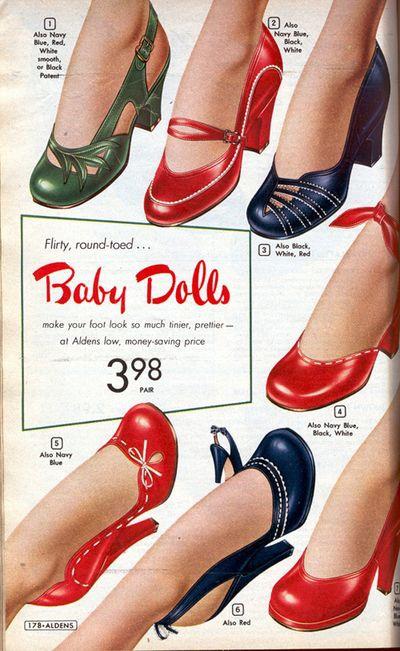
"Infant Doll" Pumps
Advertiser
For everyday article of clothing, around the business firm or running errands, a thicker low to mid heeled pump was the all-time choice. Black was the colour that went with the most outfits, so every woman had at least one pair. 1 style of day pumps were called Infant Dolls. They featured very circular toes that resembled a doll'south shoes. They came in many fun colors during the spring and summer, with cute accent decorations on the trim or an ornament on the vamp.
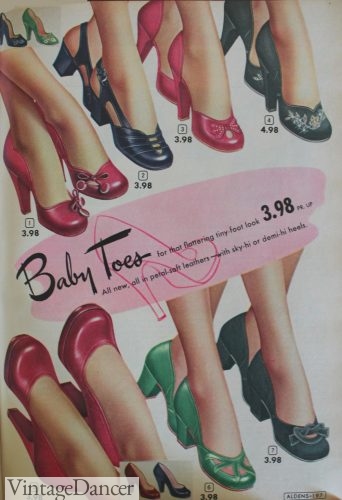
1953 "Baby Toes" Shoes
1950s Sandals
Unlike the 1940s famous peep toe sandals, the 1950s version was far more sexy. Toes were fully exposed and straps were very thin. Evening sandals showed off the nigh pes peel and had the thinnest heels. Nigh daywear sandals had lower chunky heels and a medium thick talocrural joint strap around the heel, chosen a slingback. Slingback straps were found on pumps, wedges, and slip-on coincidental shoes, too. The style assured women their feet would not sideslip out of the shoes – a dangerous and embarrassing accident.
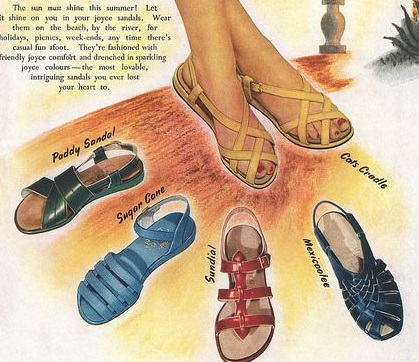
1951 Joyce sandals
The almost coincidental of all sandals was the safesole flip bomb. Women and girls loved them. Husbands, not so much. They were noisy to wear and many kids were only immune to clothing them exterior, where they couldn't be heard flip flopping away. They became very popular going into the 1960s.
Take a look at the history of sandals through the decades.
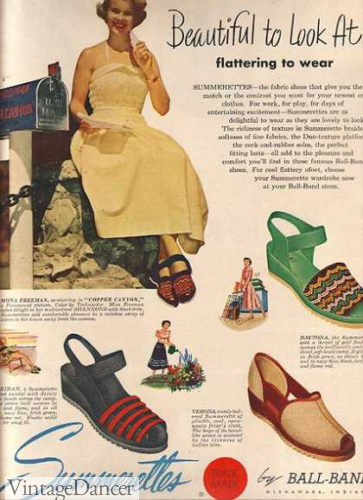
1950s wedge sandals
1950s Ballet Flats
Another 1950s shoe mode called flatties, or flats in today'south lingo, were popular equally business firm shoes. They were sometimes worn with pants exterior of the home for casual occasions. Teenagers wore them as often every bit saddle shoes when Audrey Hepburn declared them her favorites. Ballet flats featured very small heels of 1/2 inch but were the nearly trendy when they had no heels at all– merely apartment, flat, flat! Black was the most mutual color with a thin bow on the top. Other colors often matched an accessory such as a belt, scarf, handbag, or hair decoration.
Of all the flatties brands,Capezio was the cream of the crop. They were luxury for those that could afford them, but oh so divine. They had no heels, very low profile sides, deep cut on the toes to reveal toe cleavage, and had abrupt pointed toe tips. They exuded sexiness like no other apartment could!
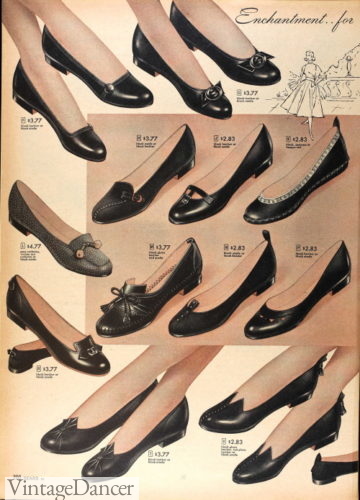
1957 black flats
Capezio and Bernardo both created a lace up flat called ghillies. Information technology was a sister to the espadrille shoe but looked more similar a cross between a human being's Oxford and a ballet shoe. The long laces provided countless entertainment in devising new ways to tie the straps. At the dorsum of the ankle was the all-time style for 1950s espadrilles, while wrapping upwards and around the leg was the vogue thing to do with ghillies. Many movies showcased women dancing in ghillies (see if you lot can spot them next fourth dimension you lot watch a 1950s musical).
Acquire more than nigh vintage flats shoes.
1950s Wedges
Beside the peep toe, the iconic shoe of the 1940s was the wedge or wedgie shoe. They were, however, equally popular in the 1950s.
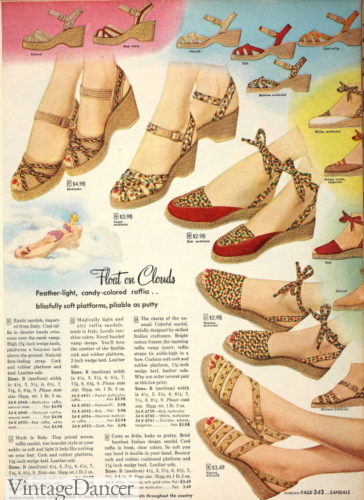
1953 wedge platform sandals
Wedges naturally retained the chunky sturdy shape and gave a nice lift to the heel (sexy!). Toe openings were bigger in the 1950s, and wedge heels were a fleck taller and curved inward for a slightly more delicate wait. Most came with a .5-inch platform sole as well, giving extra height to the wearer. They were and still are a manner that screams "vintage" or "retro" shoes!
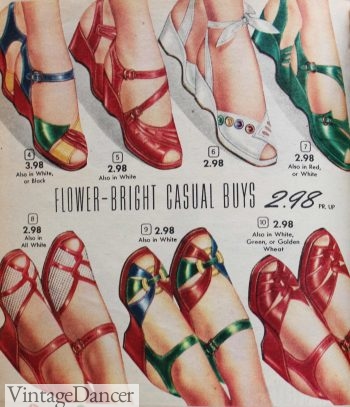
1952 Colorful Summer Wedge Heels
1950s Slippers and Mules
Only in extreme summer heat did women go without stockings. Wearing stockings with sandals was a must. Wearing them with strapless mules made for a rather slippery experience. In 1954, a solution chosen "Spring-O-Lators" featured a leather and elastic band down the inside of the mule to push the foot forward and keep the shoe on. Finally, women could article of clothing mules for evening clothing or at home as overnice bedroom slippers (not practical enough for business firm slippers, bedroom slippers were only worn with sexy lingerie equally an enticement for husbands).
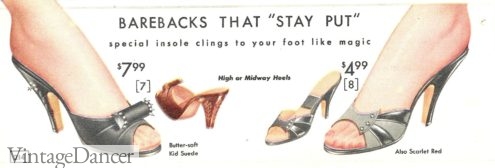
1957 Jump-o-lator mules
For summer vesture, thin heeled mule shoes and slingback sandals were in faddy. If they featured any actress adornment, it came in the class of a thin, flat bow across the toe. Straps were wide, and heels either very thin or more commonly thick and rounded.
Oxford- 1950s Saddle Shoes
Teenagers and business firm wives wore saddle shoes. These were black and white Oxford shoes well-nigh associated with teenage girls in felt poodle skirts. They were normally worn with a pair of bobby socks— white socks rolled or folded downwardly 2 or 3 times. The soles and heels were blackness forth with the center panel. White shoes and heels had to kept in pristine condition. Girls would make clean and shine their shoes nightly and buy new ones every bit before long as they began to show signs of wear. Learn nigh the history of saddle shoes and shop black and white saddle shoes hither.
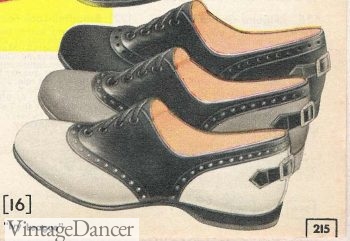
1957 Saddle Shoes
White "bucks", or nubucks, were another manner of Oxford shoe for teens. They had to be kept perfectly white all the fourth dimension. Minor "bunny bags" of chalk pulverization were included with each white buck shoe so girls could powder them on breaks. Some other white shoe was the clunky Joyce, which resembled a nurse's shoes or senior orthopedic shoes today. They as well had to be kept perfectly white at all times. Bleaching laces, polishing leather, and washing soles were all role of the nightly routine.
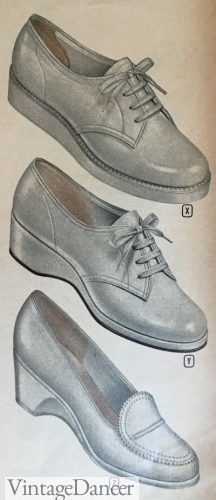
1955 White bucks and "nurse" comfort shoes
Some teens yet wore Mary Jane shoes — a single strap Oxford shoe. They were a young daughter's shoe that to teens meant you were too young to know how to keep your shoes on. Graduating to a strapless shoe meant growing upwards. There was a trend for the T-strap shoes, which returned everyone back to strapped shoes once more. Black or cherry-red were the most popular colors among 12-fifteen twelvemonth-olds. Even women jumped on the tendency with T-strap evening shoes and sandals.
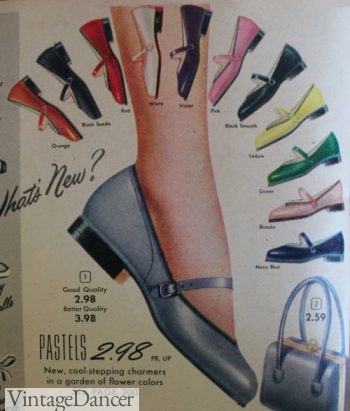
1953 Mary Jane Shoes with Low Heels
Some other teenage shoe trend in the late '50s was bunny shoes, or just bunnies. They were leather sideslip-ons in white, blackness or ruddy with ii "ears" for a tongue and wings on the heel for a bunny tail. The fad for bunnies, likewise chosen pixies, was wide spread simply brusque lived amidst girls and teens. Women's shoes, however, adopted the "ears," calling them twin peaks and placing them onto loafers and flats. The two peaks stayed in fashion into the early '60s.
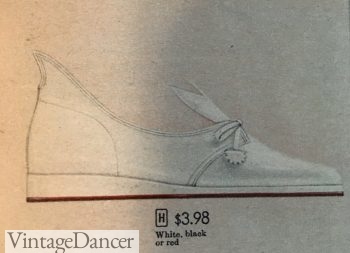
1957 Bunnies Shoes
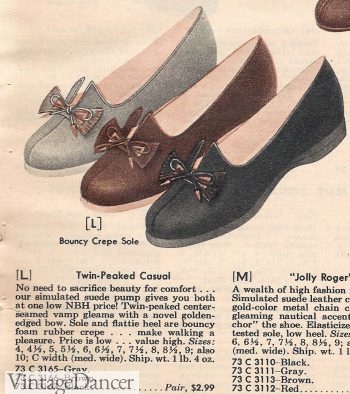
1957 Twin Acme Slipon Shoes
1950s Loafers
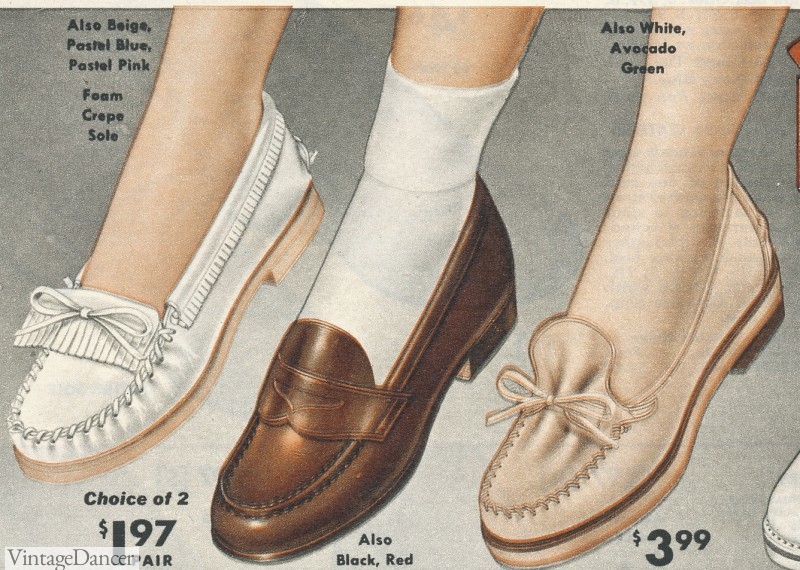
1955 Loafers and Moccasins
The most casual shoe for girls and women was the loafer. Moccasins fit into this category and were a staple in most young women's closets. Easy to skid on, available in all sorts of fun colors, casual enough to wear with bobby socks or sockless, and durable enough to last all year, they were practically perfect.
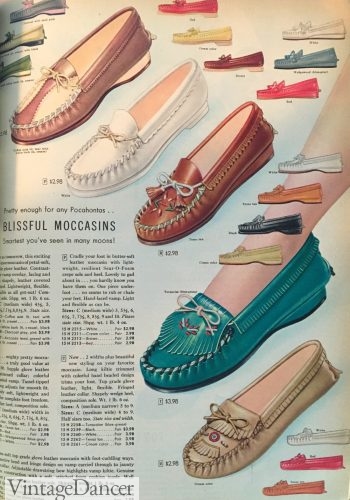
1956 Moccasin Shoes
The penny loafer got its proper noun by the slit in the decorative leather strap beyond the tongue. It was sized for a money that teens would use to call dwelling. Dark-brown or white were the most mutual penny loafer colors. Other slip on loafer shoes came in many colorful shades and shiny materials, similar patent leather or plastic. Some were articulate plastic, although they proved problematic once the foot started to sweat, turning the plastic milky white. Yuck!
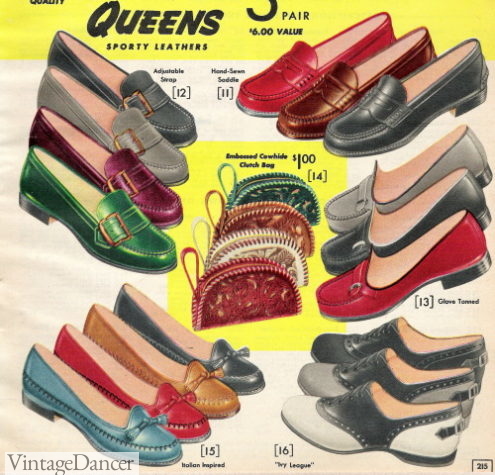
1957 loafers, flats and saddle shoes
Loafers were worn past women with sport attire, like play-suits, shorts, capri pants, and jumper dresses. Casual shoes for casual wearable was the rule. No stockings or even socks were required either.
1950s Winter Boots
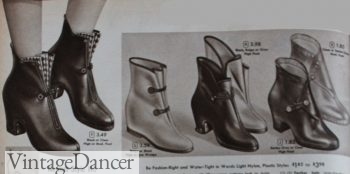
1950s pelting boot covers
With high heels and casual flats dominating 1950s footwear, the question of how women dealt with rain and snowfall in winter is a mutual one. There were a few solutions, all depending on the severity of weather.
First, the rain. Pelting boots or galoshes have gone unchanged since the outset of the 1900s. The 1950s version offered up thin rubber boot covers that attached to ane side. They were worn over shoes, mimicking the shape of women's high heels. Some other option was condom slip-in heels or loafer that were worn instead of nice shoes (which were oftentimes carried and inverse into one time inside). And finally, tall rubber rain boots like those you still see today were the ultimate in wet weather protection. Most ladies' pelting boots and shoes had a small to medium sized heel to proceed a woman looking ladylike.
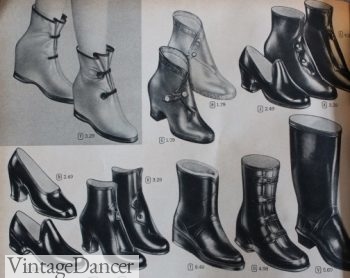
1955 Rain Boots and Shoes
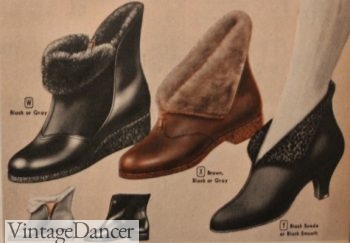
Fur Lined Boots and Booties
For snow conditions, a warmer kick was needed. Just like rain boots that were worn over heels, fur-lined snow boots also came in overshoes. There were shapely heeled boots too equally flat sole boots able to fit over Oxfords and other casual shoes. The boots came in black, white, or brown leather or condom with a zip up the front or fasted to one side. The zipper sometimes was packed in snowfall and froze shut. They were as well not well known for there watertightness. Many mothers wrapped their kids' anxiety in plastic staff of life bags earlier slipping them into boots. Information technology worked, too!
Most lined boots could exist folded over to create a gage, or folded upwardly to be a tall boot.
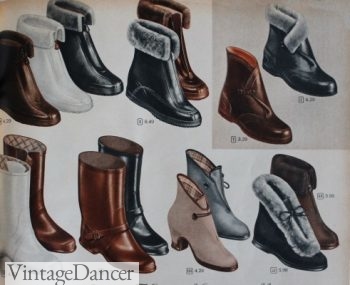
1955 Fur-lined Wintertime Boots
Wintertime snow boots and shoes came in other styles, as well, such as tall lace ups, western, or talocrural joint high booties. Lower priced boots replaced fur lining with quilting, shearling, faux shearling, or fleece.
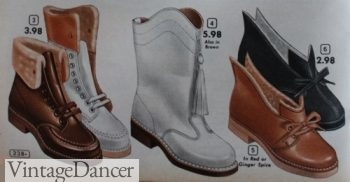
1953 Winter Mode Boots
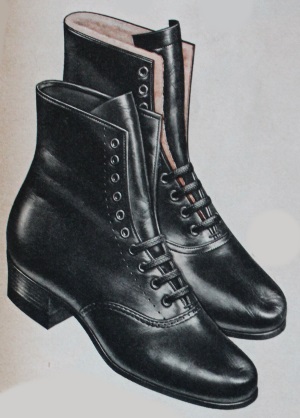
1955 Shearling-lined Lace Up Boot in a Archetype "Victorian" Pattern.
Store for vintage fashion pelting boots and snow boots here and learn nigh the history of vintage winter boots with pictures hither.
1950s Style Shoes for Auction
Many mod shoes take their roots in 1950s styles. A keen eye tin find them almost anywhere.
- New, 1950s vintage style shoes – Out handpicked favorite shoes, boots, flats and heels in the 1950s style
- Wide shoes– Vintage style shoes in a wide fit (many are likewise narrow fit brands)
- Flats – Vintage manner shoe with lilliputian or no heel
- Saddle shoes- Archetype two tone saddle oxford shoes
- Sandals – Summer sandals in vintage styles
- Oxfords – Easy, classic, oxford shoes for all seasons
- Boots – Winter boots, dressy boots.
- Wedding Shoes- Wedding shoes for your perfect day
- Slippers – House slippers and lounge shoes
- Reproduction shoe brands– Where to buy vintage repro 1950s shoes.
More Shoe History
In that location are, of course, other styles of 1950s shoes not mentioned here. Sport shoes such as Keds or Plimsolls remained popular from the 1930s onward. Various boots for piece of work or sport fashions are deserving of a time to come article of their own. Aforementioned for house slippers, sexy or practical. They were a part of every woman'due south wardrobe, nevertheless are not discussed in style history books very frequently.
If you don't see a shoe way yous desire to know more than about, leave a annotate beneath and I will add in to the next 1950s Shoe Styles: Function 2 article.
- 1920s Shoe Styles for women and Men
- 1930s Shoe Styles for women and Men
- 1940s Shoe Styles for women and Men
- 1950s Shoes for Men
- 1960s Shoe Styles for women
- History of Women's Socks – 1920s to 1960s styles, colors and trends
0 Response to "40s Fashion Guys and Dolls Costumes"
Post a Comment